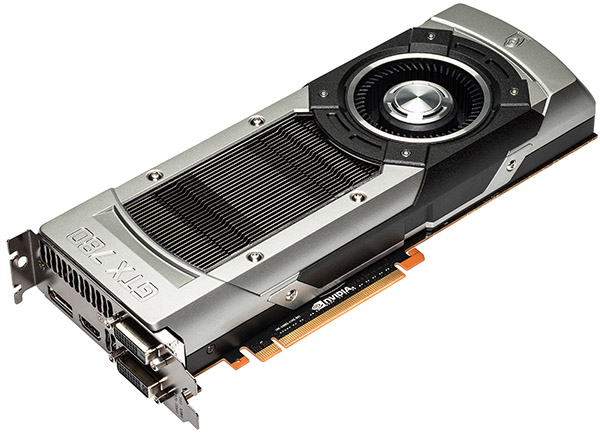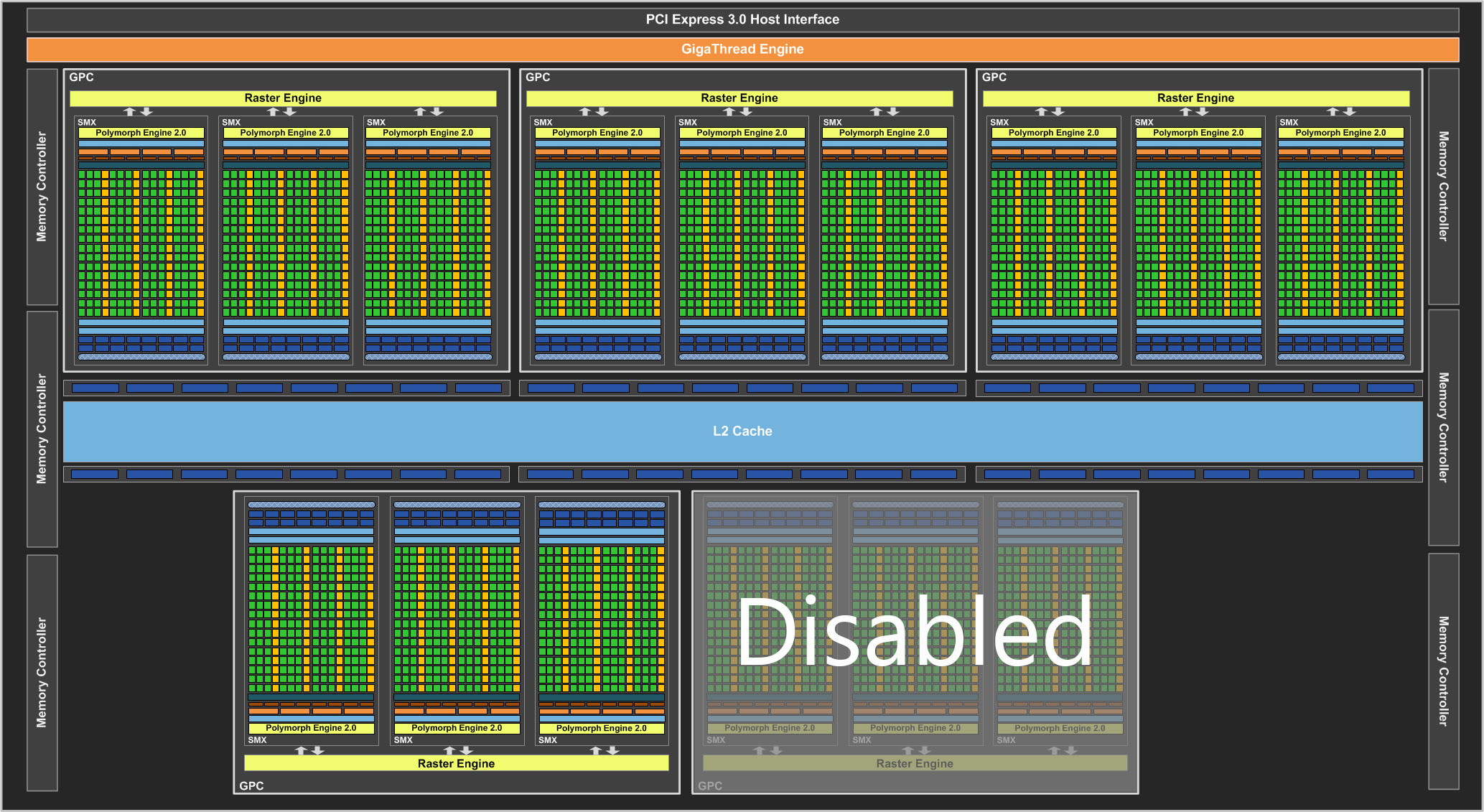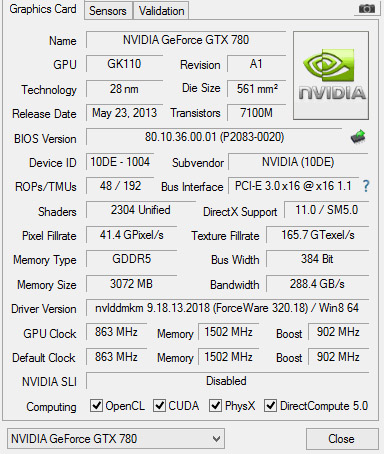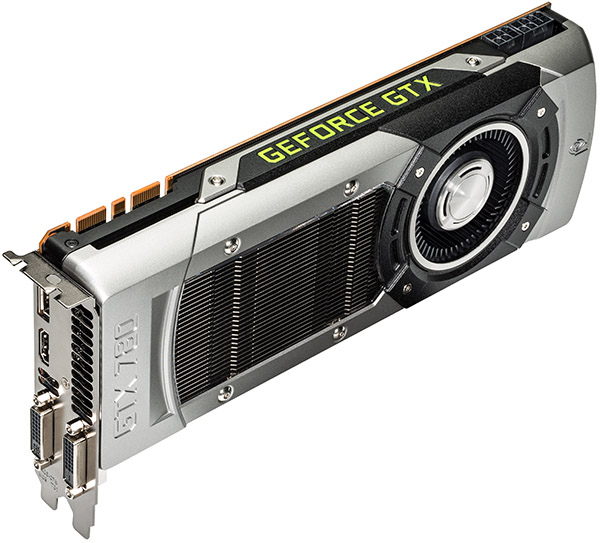Nvidia GeForce GTX 780 Review: Titan’s Baby Brother Is Born
At $1,000, GeForce GTX Titan only made sense for folks building small form factor PCs and multi-GPU powerhouses. Now there's another option with every bit of panache, a slightly de-tuned GPU, and a price tag $350 lower: meet Nvidia's GeForce GTX 780.
GK110 Gets A Little Bit Leaner
I get a kick out of looking back at what I wrote about certain pieces of high-end hardware. When Nvidia launched the GeForce GTX 680, AMD was still asking something like $550 for the Radeon HD 7970, and the GK104-based board kicked it right in the tail. It was faster, cooler, quieter, and smaller than AMD’s flagship. I recommended the 680 without hesitation. And until Nvidia launched its almost-as-fast GeForce GTX 670 for even less, the 680 was a great choice.
Today, 7970s are down to $400 or so. Meanwhile, the GTX 680s are selling for roughly $460. What a reversal, right? After some serious driver work, AMD’s Radeon HD 7970 is notably faster than the GeForce board and it costs less. You have to put up with more noise and higher power use, but the Tahiti-based card also gives you great compute horsepower to match its gaming alacrity. So long as you stay away from multi-GPU configurations, the Radeon HD 7970 is a smart buy.
The next step up is going to cost you a cool grand. Be it the GeForce GTX Titan, the GeForce GTX 690, or AMD’s Radeon HD 7990, single-card performance doesn’t get any better than a Radeon HD 7970 unless you spend twice as much. And that’s where AMD and Nvidia lose a lot of gamers otherwise down to drop big bucks on graphics. Stepping up from $500 to $1,000 is rough.
GK110 Finds A New Home In GeForce GTX 780
GeForce GTX 780 is Nvidia’s attempt to do a little something about that gaping maw of a price delta between GTX 680 and the crazy-expensive stuff. Given its name, you might think the 780 centers on a new piece of silicon. But it’s really a derivative of GeForce GTX Titan and the gargantuan GK110 GPU.
Of course, the GK110 that Nvidia uses on GeForce GTX 780 is necessarily trimmed to keep it from showing up the potent Titan. We already know that a complete GK110 GPU plays host to 15 Streaming Multiprocessors, each with 192 CUDA cores and 16 texture units. GeForce GTX Titan pares the chip back to 14 SMXes, totaling 2,688 CUDA cores and 224 texture units. GeForce GTX 780 sees GK110 further cut down to 12 SMXes. The result is 2,304 CUDA cores and 192 texture units.
Depending on the card you get, GeForce GTX 780’s 12 SMX blocks are either spread between four or five Graphics Processing Clusters. Composed of 7.1 billion transistors, GK110 is a massive chip. Manufacturing it isn’t easy. And along the way, different parts of it show up with defects. So, Nvidia can’t guarantee the exact configuration of each GeForce GTX 780’s GK110. It’ll only say that, across the GPU, 12 SMXes are enabled.
Get Tom's Hardware's best news and in-depth reviews, straight to your inbox.
Nvidia’s incisions are effective enough in dictating performance that tweaks to the board’s clock rates are very minor. GeForce GTX 780 bears an 863 MHz base frequency, just like Titan. But its rated GPU Boost clock rate is 900 MHz, whereas Titan is officially spec’ed at 876 MHz.
GK110 retains its complete render back-end, including six ROP partitions able to output eight 32-bit pixels per clock, adding up to what the company calls 48 ROP units. Further, a sextet of 64-bit memory interfaces yield the same 384-bit aggregate pathway. But whereas Nvidia armed GeForce GTX Titan with 6 GB of GDDR5 memory, GTX 780 sports 3 GB operating at 1,502 MHz. Do the math and you get the same 288.4 GB/s of peak bandwidth.
Where GeForce GTX 780 veers away from Titan is in compute potential. You’ll remember from Nvidia GeForce GTX Titan 6 GB: GK110 On A Gaming Card that Nvidia’s single-GPU flagship includes a special driver setting that scales back clock rate in favor of running the chip’s double-precision floating-point units at full-speed. This makes the GeForce GTX Titan a viable option for developers seeking more compute performance than Nvidia’s other GPUs can muster (making it competitive with AMD’s Tahiti, in fact). This time around, you still get 64 FP64 CUDA cores per SMX. But because that driver setting isn’t exposed, double-precision performance drops back to 1/24 of the FP32 rate. Expect floating-point performance to trail Radeon HD 7970 then, as FP64 throughput lags.
| Header Cell - Column 0 | GeForce GTX Titan | GeForce GTX 690 | GeForce GTX 780 | GeForce GTX 680 | Radeon HD 7970 GHz Ed. |
|---|---|---|---|---|---|
| Shaders | 2,688 | 2 x 1,536 | 2,304 | 1,536 | 2,048 |
| Texture Units | 224 | 2 x 128 | 192 | 128 | 128 |
| Full Color ROPs | 48 | 2 x 32 | 48 | 32 | 32 |
| Graphics Clock | 836 MHz | 915 MHz | 863 MHz | 1,006 MHz | 1,000 MHz |
| Texture Fillrate | 187.5 Gtex/s | 2 x 117.1 Gtex/s | 165.7 Gtex/s | 128.8 Gtex/s | 134.4 Gtex/s |
| Memory Clock | 1,502 MHZ | 1,502 MHz | 1,502 MHz | 1,502 MHz | 1,500 MHz |
| Memory Bus | 384-bit | 2 x 256-bit | 384-bit | 256-bit | 384-bit |
| Memory Bandwidth | 288.4 GB/s | 2 x 192.3 GB/s | 288.4 GB/s | 192.3 GB/s | 288 GB/s |
| Graphics RAM | 6 GB GDDR5 | 2 x 2 GB GDDR5 | 3 GB GDDR5 | 2 GB GDDR5 | 3 GB GDDR5 |
| Die Size | 551 mm2 | 2 x 294 mm2 | 551 mm2 | 294 mm2 | 365 mm2 |
| Transistors (Billion) | 7.1 | 2 x 3.54 | 7.1 | 3.54 | 4.31 |
| Process Technology | 28 nm | 28 nm | 28 nm | 28 nm | 28 nm |
| Power Connectors | 1 x 8-pin, 1 x 6-pin | 2 x 8-pin | 1 x 8-pin, 1 x 6-pin | 2 x 6-pin | 1 x 8-pin, 1 x 6-pin |
| Maximum Power | 250 W | 300 W | 250 W | 195 W | 250 W |
| Price (Street) | $1,000 | $1,000 | $650 | $460 | $450 |
Playing The Name Game
Perhaps you’re asking: Why call this card GeForce GTX 780 at all, then? It’s a derivative of Titan, based on the same Kepler architecture already prolific across the GeForce GTX 600 series. Nvidia did much the same thing with its 500 series, which built on the GeForce GTX 400’s Fermi architecture. “But the 500s were based on redesigned GPUs that improved performance, power, and, consequently, efficiency,” you rightly point out.
The most I could get from Nvidia was that it didn’t need to do this for the GeForce GTX 780, since the company only just started releasing desktop-oriented cards based on GK110. And there’s really not much room left in the 600 family to release newer, faster products. We’ll see how Nvidia fleshes out the performance and pricing of its GeForce GTX 700 line-up from here. But you can bet we’re going to expect notable performance improvements each step of the way to justify the naming. We also need continued (and compelling) competition from AMD to keep Nvidia’s pricing in check. Our best hope for that today is Radeon HD 7970.
Current page: GK110 Gets A Little Bit Leaner
Next Page GeForce GTX 780: The Card-
CrisisCauser A good alternative to the Titan. $650 was the original GTX 280 price before AMD came knocking with the Radeon 4870. I wonder if AMD has another surprise in store.Reply -
It's definitely a more reasonable priced alternative to the titan, but it's still lacking in compute. Which might disappoint some but I don't think it'll bother most people. Definitely not bad bang for buck at that price range considering how performance scales with higher priced products, but it could've been better, $550-$600 seems like a more reasonable price for this.Reply
-
hero1 This is what I have been waiting for. Nice review and I like the multi gpu tests. Thanks. Time to search the stores. Woohoo!!Reply -
natoco To much wasted silicon (just a failed high spec chip made last year, even the titan) and rebadged with all the failed sections turned off. I wanted to upgrade my gtx480 for a 780 but for the die size, the performance is to low unfortunately. It has certainly not hit the trifecta like the 680 did. Would you buy a V8 with 2 cylinders turned off even if it were cheaper? No, because it would not be as smooth as it was engineered to be, so using that analogy, No deal. customer lost till next year when they release a chip to the public that's all switched on, will never go down the turned off parts in chip route again.Reply -
EzioAs In my opinion, this card and the Titan is actually a clever product release by Nvidia. Much like the GTX 680 and GTX 670, the Titan was released at higher price (like the GTX 680) while the slightly slower GTX 780 (the GTX670 for the GTX600 series case) is at a significantly lower price but performing quite close to it's higher-end brother. We all remember when the GTX 670 launched it makes the GTX680 looks bad because the GTX 670 was 80% of the price while maintaining around 90-95% of the performance.Reply
Of course, one could argue that as we get closer to higher-end products, the performance increase is always minimal and price to performance ratio starts to increase, however, for the past 3-4 years (or so I guess), never has it been that the 2nd highest-end GPU having such low performance difference with the highest-end GPU. It's usually significant enough that the highest end GPU (GTX x80) still has it's place.
Tl;dr,
The GTX Titan was released to make the GTX 780 look incredibly good, and people (especially on the internet), will spread the news fast enough claiming the $650 release price for the GTX 780 is good and reasonable, and people who didn't even bother reading reviews and benchmarks, will take their word and pay the premium for GTX 780.
Nvidia is taking a different route to compete with AMD or one could say that they're not even trying to compete with AMD in terms of price/performance (at least for the high-end products). -
mouse24 natocoTo much wasted silicon (just a failed high spec chip made last year, even the titan) and rebadged with all the failed sections turned off. I wanted to upgrade my gtx480 for a 780 but for the die size, the performance is to low unfortunately. It has certainly not hit the trifecta like the 680 did. Would you buy a V8 with 2 cylinders turned off even if it were cheaper? No, because it would not be as smooth as it was engineered to be, so using that analogy, No deal. customer lost till next year when they release a chip to the public that's all switched on, will never go down the turned off parts in chip route again.Reply
Thats apretty bad analogy. A gpu is still smooth even with some of the cores/vram/etc turned off, it doesn't increase latency/frametimes/etc. -
godfather666 "But, I’m going to wait a week before deciding what I’d spend my money on in the high-end graphics market. "Reply
I must've missed something. Why wait a week? -
JamesSneed Natoco, your comment was so clueless. It is likely every single CPU or GPU you have ever purchased has fused off parts. Even the $1000 extreme Intel cpu has a little bit fused off since its a 6 core CPU but using a 8 core Zeon as its starting point. Your comparison to a car is idiotic.Reply -
016ive You will have to be an idiot to buy a Titan now that the 780 is here...Me, I could afford neither :)Reply




